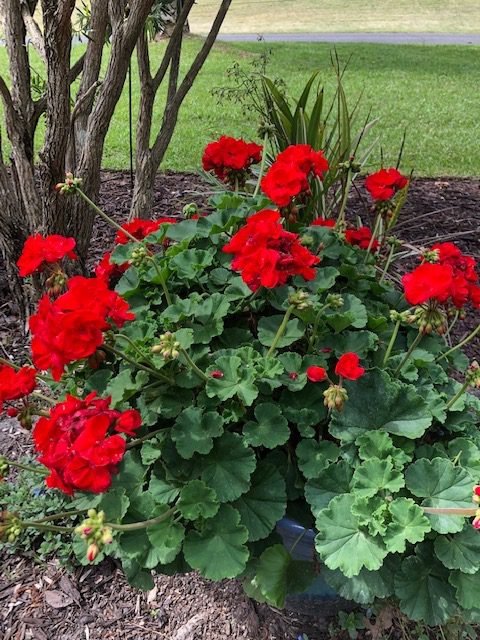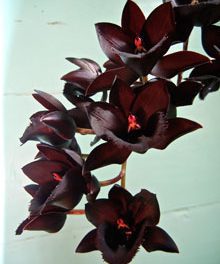 There was frost on my roof this morning, but my plants do not seem the worse for it. This is a wake up call for what we should and can do to protect tropicals and tender perennials. Many things breeze right through below freezing temps such as most perennial Salvias, Pelargoniums (Geraniums), Dianthus, snapdragons, and pansies. Tropical plants should be brought under cover on a porch or inside a garage. If you have large containers that you cannot move, cover them with cloth. Old sheets work well although your yard will look like it is decorated for Halloween. Do not use tarps or plastic –plants need to breathe. Remove the covering as soon as the temperatures are well above freezing. Keep plants hydrated during our colder days of winter. Most plants die in the winter because they dry out. You know how you feel after you have been out in the cold for a while. My mouth is always dry and I am thirsty. Your plants get thirsty too. If we have not had rain for a while, run your irrigation system once if you have one. It is also a good way to check to make certain that it is running well and there are no leaks. Marsh rats and squirrels seem to love to gnaw through irrigation lines.
There was frost on my roof this morning, but my plants do not seem the worse for it. This is a wake up call for what we should and can do to protect tropicals and tender perennials. Many things breeze right through below freezing temps such as most perennial Salvias, Pelargoniums (Geraniums), Dianthus, snapdragons, and pansies. Tropical plants should be brought under cover on a porch or inside a garage. If you have large containers that you cannot move, cover them with cloth. Old sheets work well although your yard will look like it is decorated for Halloween. Do not use tarps or plastic –plants need to breathe. Remove the covering as soon as the temperatures are well above freezing. Keep plants hydrated during our colder days of winter. Most plants die in the winter because they dry out. You know how you feel after you have been out in the cold for a while. My mouth is always dry and I am thirsty. Your plants get thirsty too. If we have not had rain for a while, run your irrigation system once if you have one. It is also a good way to check to make certain that it is running well and there are no leaks. Marsh rats and squirrels seem to love to gnaw through irrigation lines.
Now is not the time to prune. You do not wish to encourage new growth that can be nipped by the frost. The exception to this is dead branches and crossing branches that are rubbing against each other. Those can be pruned at any time.
I do not cut back ornamental grasses and most of my perennials until the end of February. They provide shelter for hibernating bees and other beneficial insects.
I only remove dead plant matter than is very moist like banana leaves or succulent material to prevent fungus. If it is dry and particularly if it has seed heads, plants can provide winter interest.
Your Camellias should be blooming now. Sansanquas bloom first and then later in the winter, the Japonicas will bloom. Prune Camellias after they bloom in the spring.
Also in flower will be Tea Olives. Tea Olive (Osmanthus fragrans) can bloom for an extremely long time all through the winter months. I have found that Tea Olives can really benefit from a good pruning when the weather gets warmer. They tend to get crossing branches and dead twigs in the center of the shrub. Loquats will bloom in January and February as well. Loquats are natives of China, but they thrive here and can grow to tree size. You can prune them to shape after they bloom and fruit. The fruits are a little odd—more giant pit than flesh and a little astringent. I have been told that they make a nice jam although I have not tried it. The squirrels and raccoons get to my Loquat fruits before I can even think about them.
Now that the soil temperature has cooled down, it is a good time to plant bulbs for spring blooms. Since our climate is so warm, bulbs need to be refrigerated for approximately 10-12 weeks to condition them for planting. When you select bulbs, be sure to look for bulbs that are good to zone 9A which is our heat index zone. Species tulips and narcissus will work well here. Certain Alliums as well will bloom.
Unfortunately, it is too hot for snowdrops, but we have our own version down here called Leucojum or “summer snowflake” that does well. It blooms later than the traditional northern snowdrops and is larger, but can put on quite a display if planted en masse. And don’t forget to plant your Christmas Amaryllis outdoors when you are through enjoying them in the house. Plant them so that the bulb is about two-thirds under the soil. They will re-bloom next spring or summer. Paperwhite narcissus can also be “recycled” and planted for blooms next winter.
Winter is a great time to plan your garden and do hardscape projects since it is cool and there are no bugs. I also amend my soil in the winter so that I am not hauling bags of compost in the heat. I like to use mushroom compost. It has organic material and tends to be alkaline which is perfect since our soil tends to be on the acidic side. Mushroom compost is easily purchased at garden centers and big box stores and is not expensive. Composted cow mature is a good soil amender as well.
If you are fortunate enough to have your own compost pile, the winter is a good time to spread that rich material on your garden beds. Leaf mold, grass clippings, vegetable waste from the kitchen, even shredded newspaper can go into a composter or compost pile and they break down rapidly in our heat to become a source of rich nutrients for your garden.
I will be doing quite a few garden projects once the holidays are over. It is a good way to work off those winter calories.












